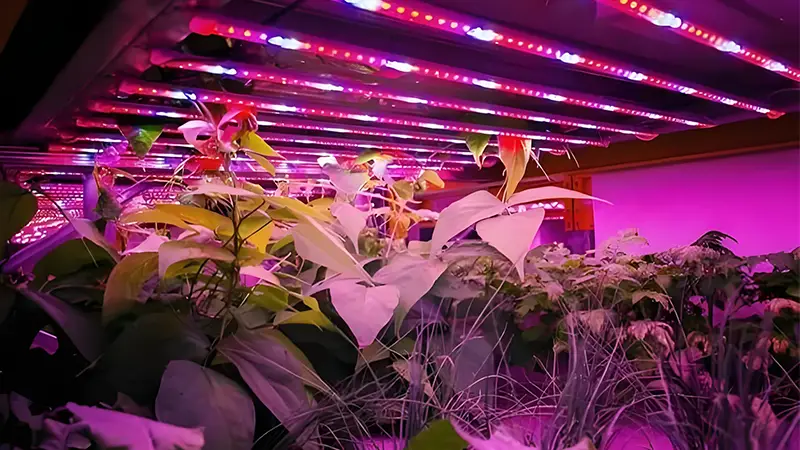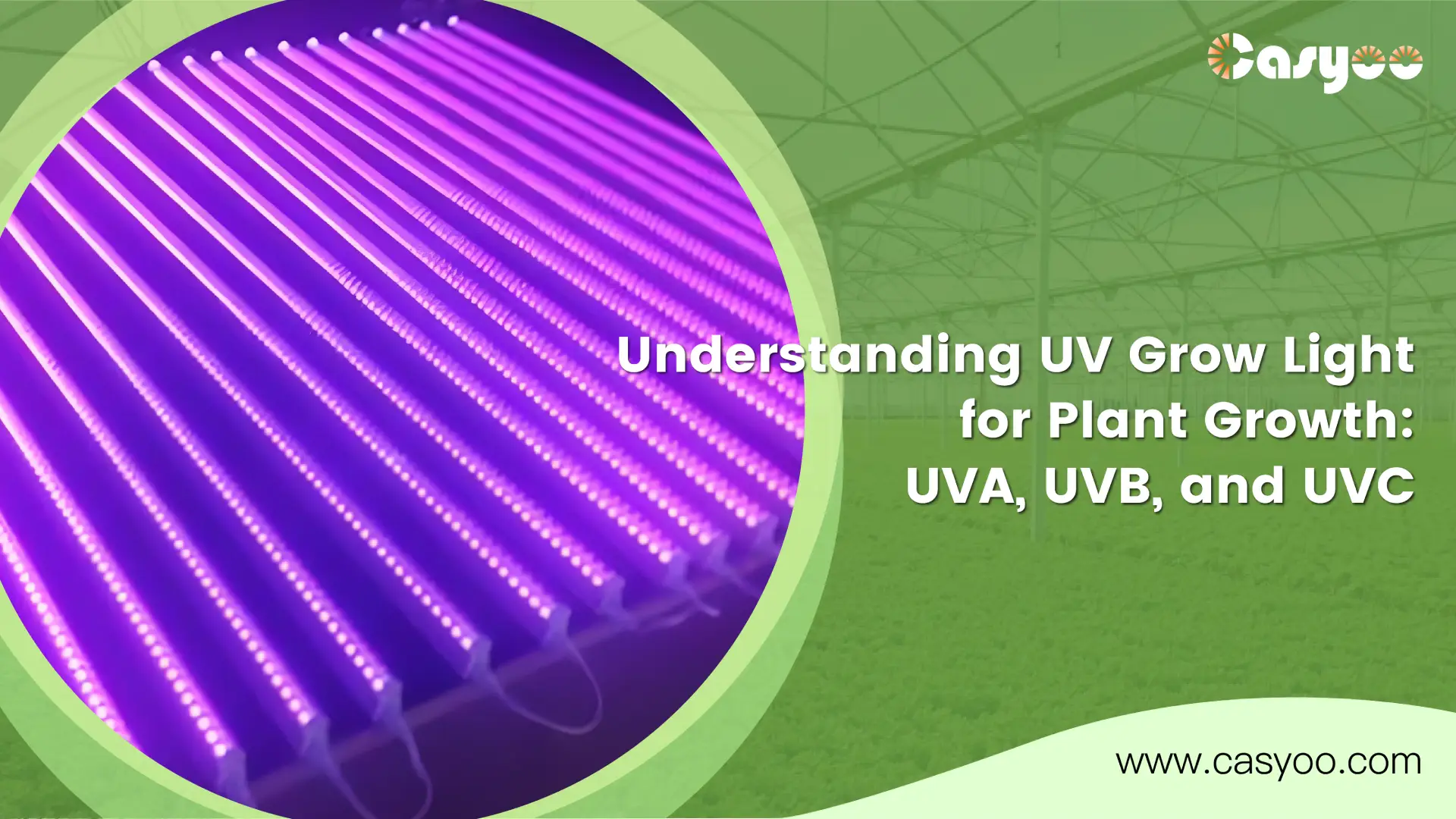Ultraviolet (UV) light is an important a part of the electromagnetic spectrum, sitting simply past the visible spectrum of mild that plant life generally use for photosynthesis. While plants mainly rely on seen light, particularly the blue and red wavelengths, UV mild also can play a good sized position of their growth, improvement, and health. In this weblog, we are able to discover the three major kinds of UV Grow light—UVA, UVB, and UVC—and decide which is best for plant increase.
Introduction to UV Grow Light
Before diving into the specifics of UVA, UVB, and UVC, it’s critical to understand what UV light is and the way it interacts with vegetation. UV light, like visible mild, is a shape of electromagnetic radiation. It has shorter wavelengths than seen light, which offers it the capacity to penetrate deeper into biological tissues. However, UV light is likewise greater lively, and excessive exposure can purpose harm to living organisms, inclusive of vegetation.
UV light is divided into three classes based totally on wavelength:
- UVA (320–four hundred nm): The least harmful and longest wavelength of UV radiation. It can penetrate deeper into the plant and is important for various growth approaches.
- UVB (290–320 nm): This wavelength is extra active and can reason damage to plant cells if publicity is too excessive, however it is also vital for sure plant processes just like the manufacturing of shielding compounds.
- UVC (100–290 nm): The maximum dangerous UV radiation. Fortunately, maximum UVC radiation is absorbed by way of the Earth’s ozone layer and does no longer attain the surface. However, synthetic assets of UVC may be used for sterilization functions.
The Role of UV Grow Light in Plant Growth
Plants require light for photosynthesis, the method by which they convert mild energy into chemical strength to gas growth. While visible light (the mild we can see) is the number one source for photosynthesis, UV light can have an impact on several elements of plant biology past simply photosynthesis.
In fashionable, UV light:
- Stimulates the production of secondary metabolites, that are crucial for plant protection.
- Affects the synthesis of plant hormones, like auxins, which adjust increase and development.
- Can boom the plant’s resistance to illnesses and pests by promoting the production of shielding compounds, like flavonoids and anthocyanins.
- Affects plant morphology and model to environmental pressure.
Each sort of UV mild has distinct consequences on flowers. To better apprehend how UVA, UVB, and UVC make contributions to plant growth, let’s damage them down in my opinion.
UVA Light: The Beneficial, Gentle UV
What is UVA Light?
UVA light falls within the range of 320-400 nm. The lowest harmful UV radiation forms a significant percentage of UV reaching the Earth’s surface. Though less energetic than both UVB and UVC radiation, it still causes some biological impact on plants.
Effects of UVA on Plants
UVA is important for plants in their growth and development; it influences, in one way or another, the following events:
- Complementary photosynthetic efficiency:Although it does not feed into the photosynthetic apparatus, it’s been noticed that some types of plants that are treated under UVA light exhibit the enhancement of photosynthetic ability. This may be an effect due to changes in plant structural feature or induction of a key enzyme.
- Production of Secondary Metabolites:It has been reported that UVA light triggers the synthesis of secondary metabolites in plants. Such chemical compounds involve flavonoids, anthocyanins, and terpenoids, which plants use for protection against herbivores and pathogens and to cope with stress. Such compounds are also beneficial to humans because they have antioxidant action.
- Morphological Changes:UVA exposition modifies plant morphology, particularly on traits such as leaf size, stem elongation, and branching. Some of the studies indicated that UVA can induce compactness in growth, thus generating stronger and more resilient plants.
- Stress Tolerance: UVA has been associated with increased stress tolerance in plants. UVA light can acclimate plants to extreme conditions such as drought or high temperatures by inducing the production of various protective proteins and compounds.
Should You Use UVA for Plant Growth?
In general, UVA light is beneficial for most plants, especially in promoting secondary metabolites and improving stress resistance. Since UVA is not as harmful as UVB or UVC, it can be used to stimulate plant growth and defense mechanisms in controlled environments like greenhouses or indoor grow rooms.
UVB Light: The Growth Stimulator and Protector
What is UVB Light?
UVB has a wavelength of 290 – 320 nm. It is greater active than UVA and can be injurious to residing tissues at excessive intensity. On the other hand, UVB is also in some way crucial in stimulating the boom of flowers in addition to of their improvement.
Effects of UVB on Plants
- Improved Production of Secondary Metabolites:Similar to UVA, UVB enhances the production of secondary metabolites. Specifically, it’s miles regarded that UVB induces the synthesis of phenolic compounds, which can be implicated in plant resistance to herbivores and pathogens. This includes compounds which includes flavonoids, which have antioxidant houses.
- Plant Defense Mechanisms:UVB radiation induces the production of sure compounds that make plants more proof against UV radiation, insects, and sicknesses. It may additionally moreover result in the production of thicker mobile walls, better concentrations of shielding chemical substances, and extended tiers of antioxidants.
- DNA Repair and Protection:UVB is understood to reason DNA damage in flowers; alternatively, it triggers the DNA restore mechanism. Although prolonged publicity to UVB is adverse, short, artificial UVB exposures can result in the development of higher mechanisms for DNA repair in flora, for this reason making them extra proof towards damage over an prolonged period.
- Influence on Growth and Development:Moderate publicity to UVB can influence plant growth via changes in gene expression and law of plant hormones. Some plant life, upon UVB radiation, may additionally moreover exhibit stunted increase, but this will additionally be due to the fact the plant is channeling its electricity to protection mechanisms in preference to rapid growth. In a few instances, UVB can spark off the producing of hormones that regulate flowering and fruiting.
Should You Use UVB for Plant Growth?
UVB radiation is beneficial for plants but want to be used carefully. While it complements the manufacturing of secondary metabolites and plant safety mechanisms, immoderate publicity can harm plant tissues and stunt increase. To harness the blessings of UVB, it is important to govern exposure and use it carefully, in particular for plant life that need more safety from pests or illness.
UVC Light: The Dangerous, Sterilizing UV
What is UVC Light?
UVC light, with wavelengths between 100 and 290 nm, is the most hazardous form of UV radiation. It is extremely energetic and can cause severe damage to biological tissues. Fortunately, most UVC radiation is absorbed by the Earth’s ozone layer and does not reach the surface.
However, artificial sources of UVC, including germicidal lamps, are occasionally used in controlled environments for sterilization applications. UVC light also can be used to kill pathogens such as bacteria and fungi on plant life, but its damaging effects on plant cells must not be overlooked.
Effects of UVC on Plants
- Cell Damage: The radiation in UVC can cause injury to the cells of a plant by the breaking of chemical bonds, including DNA strands. Such an effect ultimately causes the death of those cells and reduces photosynthesis efficiency and overall plant growth.
- Inhibition of Photosynthesis: With such harmful UVC radiation, the photochemical processes get disrupted during light exposure. It inhibits chloroplasts’ ability to transform light energy into chemical energy, thus leading to stunt growth and tissue necrosis.
- Sterilization and Pathogen Control: Although UVC is toxic to vegetation, it can still be used for sterilization purposes in manipulating pathogens. UVC light is capable of killing bacteria, fungi, and viruses, thereby acting advantageously in preventing plant diseases. It should, however, be sparingly used with caution in order not to adversely affect the plant.
Should You Use UVC for Plant Growth?
UVC radiation is normally to be avoided in the plant growth environment due to its destructive nature. While it is useful in pathogen control, its negative impact on plant tissues outweighs any potential benefits by a large margin. If you have to sterilize surfaces or air in your grow room, UVC light can be used, but plant life should be kept from direct exposure.

Which Type of UV Grow Light is Best for Plant Growth?
Different UV grow light have different effects and are suitable for the growth of different plants in different scenarios. Below, we will introduce the applicable scenarios of UVA, UVB, and UVC:
- UVA: The most suitable for promoting healthy plant growth, enhancing plant metabolism, and improving plant resistance. Compared to UVB and UVC, it causes the least damage to plants and can be used with more peace of mind.
- UVB:Good for secondary metabolite manufacturing and improving plant protection mechanisms, but use with caution to prevent overexposure.
- UVC:Should no longer be used for plant boom, in widespread, because it has dangerous outcomes. Can be used for sterilization techniques, but any direct contact with plants is destructive.
UV Grow Light in Grow Environments
In grow environments like greenhouses or indoor farms, a aggregate of visible mild and UVA/UVB light is often great for maximizing plant fitness, growth, and resistance. UVC moderate must be reserved for sterilization capabilities simplest and never used straight away on flora. High quality grow lights on the market not only emit visible light, but also provide the necessary ultraviolet radiation for plants.
By the utility of managed amounts of UVA and UVB, you could elicit plants for greater shielding compounds, beautify their resilience, or even promote higher increase. If you’re growing plant life indoors and seeking to maximize increase potential, incorporating UV moderate into your setup can supply your flowers the greater beautify they want to thrive.




